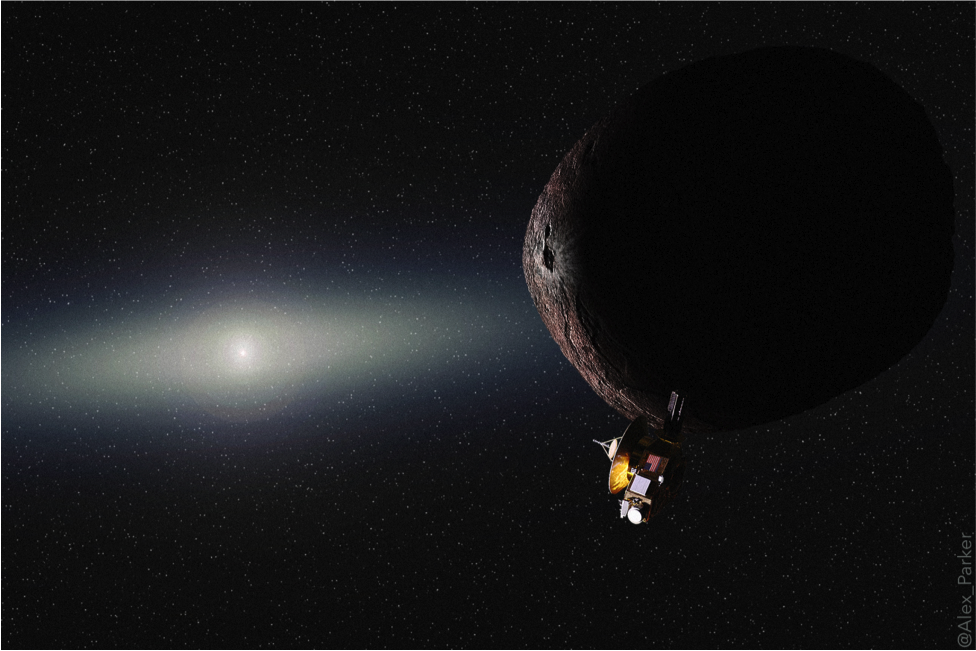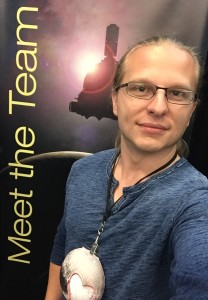Today’s post is written by Alex Parker, a research scientist at the Southwest Research Institute in Boulder, Colorado, working on NASA’s New Horizons mission.
Pluto and its moons are the most distant worlds ever visited by any of humanity’s robotic explorers, but for how much longer will that remain true? New Horizons is outbound through the Kuiper Belt, and two years ago today we discovered a smaller, more distant world that we could send it to. Likely an icy relic left behind from the era of planet formation, this world lies nearly a billion miles further from the sun than Pluto. While it will eventually be named something befitting such a world, it is currently designated 2014 MU69, and if New Horizons’ extended mission is approved by NASA, it will become the new most distant world ever explored on Jan. 1, 2019.
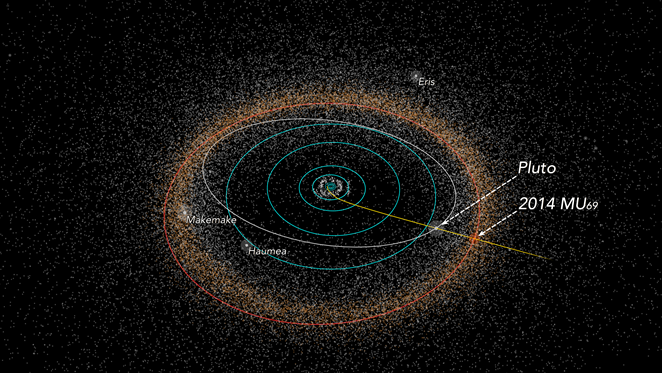
It took years of effort from a dedicated team to find somewhere that New Horizons could visit after Pluto. We scoured the southern skies with Earth-bound and space-borne observatories, battling poor weather, unforeseeable hardware faults, and the endless interference of the dense star fields of Sagittarius, at the very center of our home galaxy itself. That search discovered over 50 new Kuiper Belt objects, and culminated with the discovery of New Horizons’ potential post-Pluto target, 2014 MU69.
What follows is a brief look back at that search, the discovery of 2014 MU69, and what it portends for the future of New Horizons and outer solar system exploration.
The Search Begins
Finding New Horizons a post-Pluto target in the Kuiper Belt was a long-standing mission goal. It was even included as a component of the original mission proposal in 2001 that New Horizons have the capacity for exploring a more distant Kuiper Belt object, should one be found that it could reach.
That last bit was the catch — at the time that New Horizons was designed, assembled, and launched, there were no suitable Kuiper Belt objects known near enough to the path that it would take out of the solar system for it to reach one after Pluto. Given that the first decade of the 21st century saw the peak rate of new Kuiper Belt object discoveries in all of history to date, why weren’t more known in the region of sky around Pluto?
Because that area of sky is one of the hardest to search for Kuiper Belt objects. It lies in front of the center of our galaxy and is packed full to brimming with background stars. For every Kuiper Belt object as faint as 2014 MU69 in our images, there were tens of thousands of stars far brighter.
Additionally, there was a quirk to the search that made waiting preferable: the longer we waited, the less sky we would have to search. You can imagine the swarm of possible Kuiper Belt objects that New Horizons could reach, all orbiting the sun on different paths with one common feature — those paths intersect with the path of New Horizons. As you go backward in time from the period during which New Horizons is passing through the Kuiper Belt, the paths of these Kuiper Belt objects diverge from one another, and they spread out like a dissipating cloud across the sky. The earlier we performed the search, then, the more sky we would have to cover in order to find these Kuiper Belt objects.
The first searches for a post-Pluto target were performed in 2004 at the Subaru observatory. At the time, the swarm of Kuiper Belt objects was quite spread out, so the search was performed over a relatively large area of sky without spending too long in any one area. These data were a large part of what was searched by the IceHunters citizen science effort, and a number of relatively bright Kuiper Belt objects were discovered in it, though none were within reach of New Horizons.
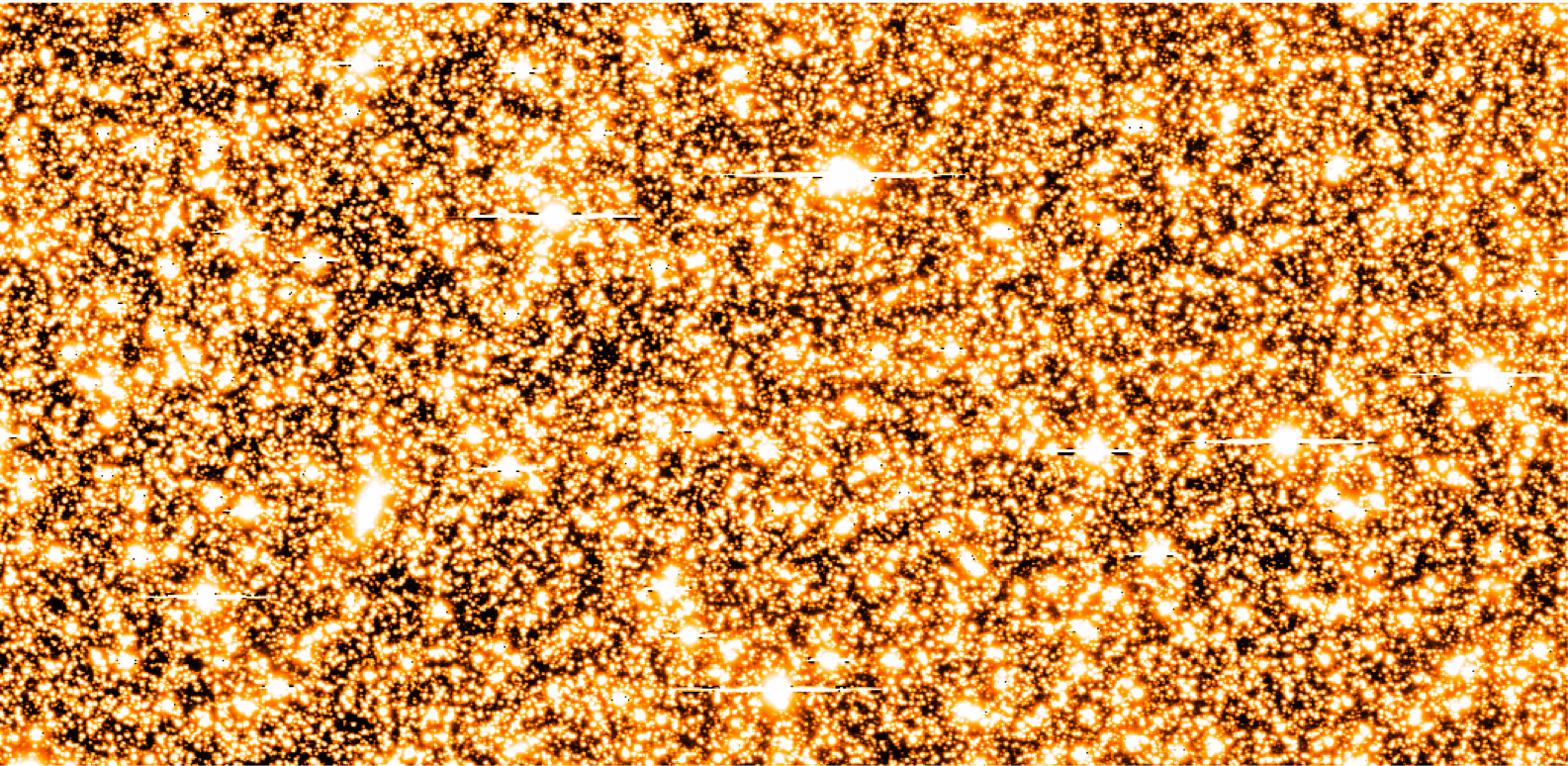
I came into the project in 2011, with our first Magellan observatory survey. The twin Magellan telescopes are situated adjacent to one another atop Las Campanas in Chile. While slightly smaller telescopes than Subaru, their site delivered us some of the best atmospheric conditions of the entire search. Since it was later than the first Subaru search, we did not have to search as much sky to cover the full swarm of targetable Kuiper Belt objects. This meant we could spend more time on each area, and see fainter Kuiper Belt objects.
But the challenge of the Milky Way remained. Above is an example of what just a portion of one of our raw images looks like. Every star you can see in this image is many times brighter than the other Kuiper Belt objects we were looking for.
I joined the search as a postdoctoral researcher at the Harvard-Smithsonian Center for Astrophysics in 2011. There I was working on ways to suppress the stars in our images while leaving behind any and all objects that move like Kuiper Belt objects. These methods also had to compensate for the constantly-shifting blurring caused by the Earth’s atmosphere.
With lots of nights at the telescopes in Hawaii and Chile, lots of algorithm and code development, lots of CPUs crunching through the data, and lots of time spent scrubbing through the results manually to make sure nothing was missed, we turned up dozens of new KBOs between 2011 and 2013. Yet, while many of them came close to New Horizons’ path, still none of them were quite within reach of its fuel supply.
Taking The Search To Space
Time was growing tight, and we had to make a decision. We needed to not only find a targetable KBO, but we also needed to track its orbit over a long enough period of time that we could predict where it would be with the accuracy needed to target New Horizons for a hair-raising few-thousand-kilometer flyby. The longer we waited, the easier the search was to do, as the diffuse swarm of potentially-targetable KBOs slowly collapsed into a tight spot on the sky as the encounter dates approached. However, the time remaining for accurate follow up and orbital measurement got ever shorter.
2014 balanced both of these needs. It was the last year in which enough time remained to accurately measure any KBOs’ orbits well enough to target them with New Horizons, and it was late enough that the area of sky covered by potential targets had shrunk to the point that Alan Stern, the principal investigator of New Horizons, indicated that it was time to consider using our weapon of last resort: NASA’s Hubble Space Telescope.
Hubble has unrivaled sensitivity, and since it orbits above the Earth’s atmosphere, its unobscured view would permit us to search for KBOs hiding in front of our galaxy. The millions of background stars we had been contending with would be far less trouble for Hubble’s sharp vision.
That said, we knew that the survey we were asking for had no precedent. It would be the largest dedicated search for solar system objects ever conducted with Hubble. It would need to be designed with the utmost care, it would need to execute flawlessly, and the solar system would need to cooperate with us. And we would need to convince a panel of reviewers that this survey’s potential value outweighed the risk of coming up empty after investing so much of Hubble’s time.
As you might imagine, a request for the amount of Hubble time we needed could not be taken lightly, and the proposal was not a slap-dash affair. We painstakingly developed a risk-mitigating strategy that would both ensure our best chance of success while minimizing the amount of precious telescope time that would be wasted if the solar system did not cooperate by providing us with a targetable Kuiper Belt object.
Part of that strategy was a two-part search. We would perform a pilot project and prove that we could discover as many Kuiper Belt objects as our models predicted before proceeding with the larger main survey. We had a tight deadline to deliver this proof, with about two weeks to analyze this unprecedented new dataset, deliver our new discoveries, and pass the go-no go threshold for the full program.
With this strategy in place, we were awarded the time. And that was when things got really interesting.
In mid-June of 2014, we learned that our proposal had been selected, and that it was scheduled for immediate execution on Hubble. I quickly booked a flight to Boulder to join the rest of the team for the push to beat the tight demonstration deadline. I arrived in Boulder just as the first of the data was being collected by Hubble, orbiting somewhere far overhead.
I didn’t know it at the time, but the intense search effort that followed was a preview of what the following summer would be like as New Horizons flew by Pluto.
There was no good demonstration data to tune our tools on, which meant that we went in cold and had to write our analysis software on the fly. We were developing new software and refining the speed and sensitivity with which we could handle the data as it streamed down from space.
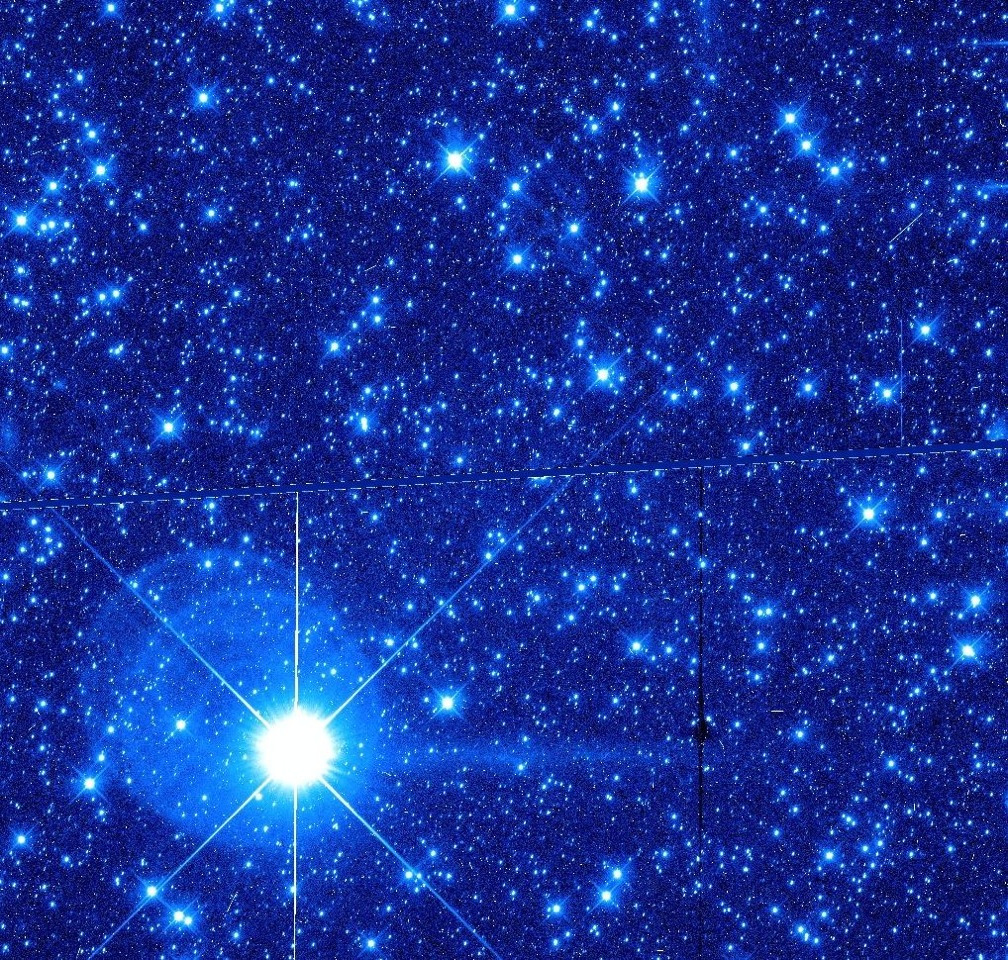
We had to convince energy-conscious building managers to keep the HVAC running late into the night and over the weekends to keep the offices and server rooms at livable temperatures during the summer Colorado heat. In parallel, there was another team on the East coast working to make sure that an independent and redundant pipeline was developed and running. We checked each teams’ performance by placing synthetic KBOs of known brightness in the data and determining how faint they could be before our software stopped finding them reliably.
It was exactly two years ago – on June 28, 2014 – that our search first bore fruit. Marc Buie alerted the Boulder team that he had spotted something in the data, and subsequent analysis by all the involved teams confirmed that it was a Kuiper Belt object. Eventually, this first discovery would be designated 2014 MU69.
We quickly found another Kuiper Belt object, and passed the go-no go. After all was said and done, we found five new extremely faint Kuiper Belt objects in this search data, with three candidates with promising orbits that might make them targetable.
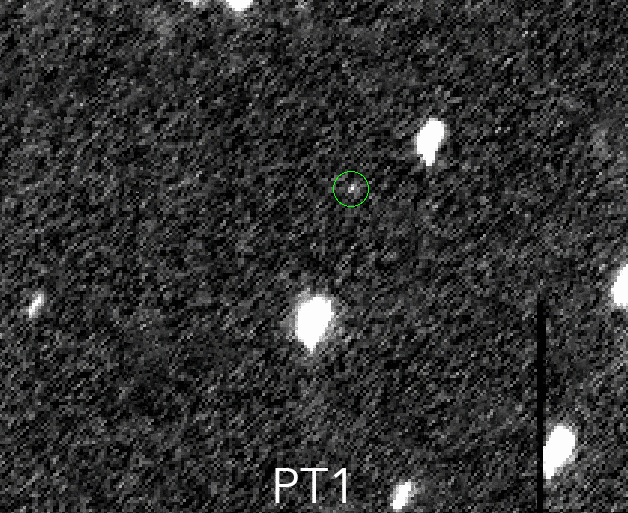
The discovery observations alone were enough to suggest that 2014 MU69 might be targetable by New Horizons, but it would take further follow up to confirm it. In August of 2014, a batch of Hubble observations picked up 2014 MU69 again, and with those new observations my analysis of the orbit concluded that it was guaranteed to be targetable given New Horizons’ fuel reserves. Even if no others panned out, we had a world we could reach.
In the end, two of the five candidates withstood the test of subsequent observations. Of those two, it was still the first that we discovered that remained the best candidate, and so it was that 2014 MU69 was selected as the nominal target of a potential New Horizons extended mission.
But just discovering a targetable world was not enough.
Tracking, Targeting, And Understanding A New World
Pluto had been tracked for 85 years—well over a third of its orbital period, before New Horizons arrived. 2014 MU69 lives deeper in the Kuiper Belt than Pluto, and takes nearly 300 years to orbit the sun. We only discovered it two years ago. By the time we fly by it, we will have known about it for only one and a half of one percent of its orbital period. This short baseline of observations means that in order to predict the position of 2014 MU69 with sufficient accuracy and precision to fly a spacecraft by it, we would need exquisitely calibrated observations between now and the flyby.
Since its discovery, we have continued to track 2014 MU69 with Hubble. Once these extremely accurate observations are linked with the extremely precise GAIA astrometric network, we will have an orbit solution for 2014 MU69 that is unparalleled for the period of time that it has been tracked.
From its orbit, we have already learned that 2014 MU69 is a very intriguing kind of Kuiper Belt object. It belongs to the “Cold Classical” Kuiper Belt, a population that appears to be a surviving remnant of the disk of material from which the planets formed. The cold classicals seem to have escaped much of the violent processing that other kinds of minor planets were subject to. This makes 2014 MU69 the clearest window into the era of planet formation that we have ever had the chance to see up close.
The Burn
All of our effort in finding 2014 MU69 opened the door to a potential extended mission for New Horizons. After the Pluto flyby in the summer of 2015, we and the spacecraft and navigation teams designed the largest spacecraft maneuver ever performed beyond Neptune. This maneuver would adjust New Horizons’ course to intersect the orbit of 2014 MU69 on Jan. 1, 2019. It would also be the largest series of engine burns New Horizons had ever attempted.
The maneuvers to do this began in October of 2015, and took several weeks to perform. After it was complete in November, New Horizons had 2014 MU69 in its sights. We were on our way.
The Extended Mission
New Horizons has targeted 2014 MU69, and we have proposed to NASA for an extended mission that would support the flyby of this distant world. This extended mission proposal is still under consideration. If approved, we will not only explore 2014 MU69, we will also study about 20 of the other Kuiper Belt objects that we discovered in our ground- and space-based searches. We won’t approach these worlds nearly as close as 2014 MU69, but New Horizons’ unique vantage point still makes it possible for us to examine them in more detail than is possible with any other facility.
Then, on Jan. 1, 2019, New Horizons will cruise over the surface of 2014 MU69, and the speck that we spotted in Hubble’s images two years ago will turn into a real world before our eyes.
